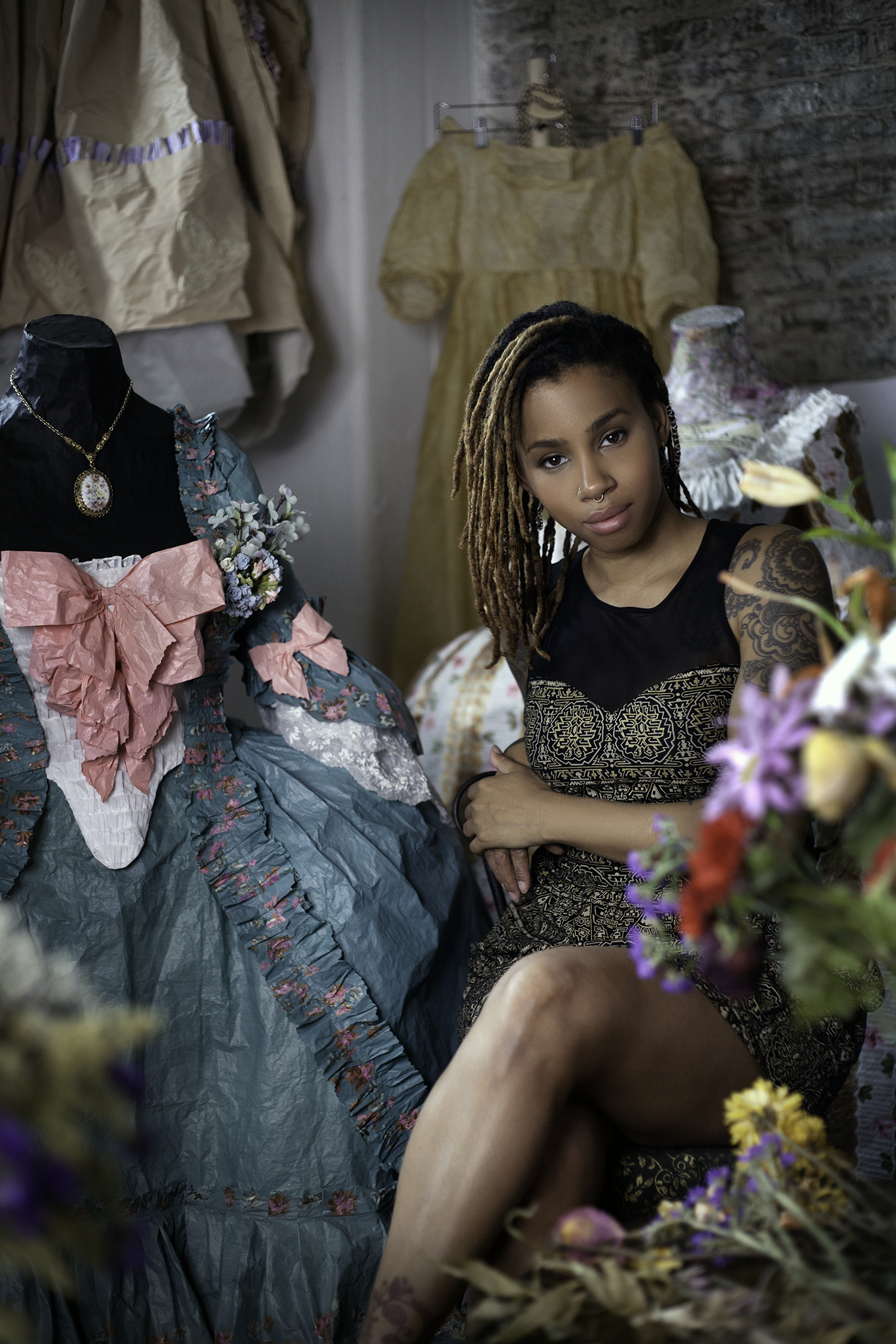Fabiola Jean-Louis
Editor's Note: Brooklyn-based Fabiola Jean-Louis wishes that she could rewrite history.[1] Her artistic practice, which is deeply embedded in the cultural politics and discourses of the Black Lives Matter movement, stands as a potent commentary on contemporary race relations but makes liberal references to the past. Her stunning body of work—which also weaves together sci-fi and Surrealist themes—is a form of “visual storytelling” that confidently straddles the artistic disciplines of photography, video art, sculpture, and performance. Fabiola’s favored medium, however, is fabric—or at least that’s what it seems. The sumptuous gilded and embroidered textiles that are such a presence in her work are actually made of paper, which she weaves into recognizable seventeenth- and eighteenth-century silhouettes.
Her work is thus ripe for interpretation through the lenses of fashion history and theory. Although fairly new to the New York art scene, her work has been enthusiastically received, being featured in the Brooklyn Reader, Huffington Post, and RollingOut, among other publications, while she has become a favorite figure on the AfroPunk scene. Fabiola is presently preparing new work that will be shown this fall at the Dusable Museum of African American History and Alan Avery Art Company. As busy as she is, however, she managed to find an afternoon to open up her studio doors to FSJ’s Kim Jenkins to share her passions and practice. Kim’s account of her visit follows.
I visited Haitian-born artist, Fabiola Jean-Louis in her studio near the Brooklyn Navy Yards. Fabiola stands in a flowing white tunic with her gaze fixed on a small, crafted shoe she’s painting. The delicate piece of footwear will be added to her collection, “Rewriting History,” which has been a work in progress over the last couple of years. As you walk around the space, you’re surrounded by a constellation of work, from photographed portraits to headdresses to, what Fabiola is most well-known for: elaborate paper dresses. Easily mistaken for fabric garments, it’s the uncanniness of Fabiola’s paper dresses that attests to her unwavering attention to detail and appreciation for fashion history. There’s an observable indication of progress as the eye pans the spectrum of her work across the room–earlier dresses that appeared suitable for a damsel have now evolved into a gown fit for a 18th-century queen. What used to take one month to construct now takes five months, and Fabiola attributes the deepening of her artistic practice to the museum catalogs and pattern books stacked across the two craft tables nearby. Prior to her discovery of the catalogs, Fabiola managed with a limited perspective, using flat, forward-facing 16th and 17th century paintings as her guide. The latest nuances include paper designed to mimic opulent European textiles, overlaid with intricate patterns and meticulously detailed beadwork. Fabiola recounted her early concept-to-design methodology to me, maintaining her gaze on the shoe in hand, tapping out a dash of glitter. As a busy artist, she would have an assistant from time to time for general studio work, but an assistant couldn’t replicate the visual representations that Fabiola stored in her mind. Working from visualizations alone (no sketching), she would paint and build the paper dress to the form–similar to a modern-day Madeleine Vionnet.
Turning the gaze upwards, there’s a nightgown suspended from the ceiling. Crafted from paper and worked into a soft, linen-like texture, the materiality of paper enables the appearance of a garment that was embodied, with its creases, wrinkles and loosened sleeve holes. The design is deliberate. As you examine the nightgown, Fabiola implores you to imagine the body that formerly occupied it. I also imagined Joanne Entwistle taking in this work, considering how craft can convey and deliciously complicate her theory of fashion as a situated bodily practice. Then I wondered what curator Judith Clark would think, seeing these glorious spectres around the room.
However, upon closer examination, from the tea-stained nightgown to her recently completed grand pannier dress, there’s a far more complicated narrative for the dress’ assumed wearer than meets the eye. “My work always centralizes around the black and brown female body, and it’s looking at society–our place in society,” Fabiola responds, as I seek to situate the intent for her designs. It’s a manifesto materialized, with one of the paper dresses holding a small tableau embedded in the torso of the bodice, subversively replacing the traditional stomacher: a black man hangs from the branches of a blossomed tree, leaving a remark on the haunted and devalued black body. As I see it, the dresses that Fabiola conceives end up with an agency all their own, advocating for the unassumed (historically speaking) black and brown women they were made for, and Fabiola takes one step further as the midwife, staging photographed portraits that bear models returning the gaze in these fashioned pieces.
It becomes absolutely coherent that Fabiola Jean-Louis is reimagining and rewriting (fashion) history, and she’s appropriating European historical fashionable dress with a motive. When I asked if she had considered African textiles, she had no interest in working with them. Though it’s not with a disinterest in the cultural significance and material complexity of African textiles, it’s that Fabiola prefers to seize what is deemed precious, luxurious, and conspicuous to European material culture and present a pastiche that disturbs the subject of early fashion portraiture and its relation to power and leisure. And it’s not just about having a lovely dress embodied by a black or brown woman’s body, it’s precisely about having the privilege of leisure to stand around in the dress, Fabiola emphasizes as we engage in dialogue about black bodies and precarious social frameworks of power. The models that pose for her portraits (including her teenage daughter) pose a new narrative, a new way of representing fashion that will inspire young black and brown girls and encourage their elders. “Rewriting History” strikes at the pillars of fashionability and privilege, and with the shards of a troubled past, we can construct something anew.
Notes
[1] http://www.huffingtonpost.com/omo-misha/rewriting-history_1_b_9648496.html






